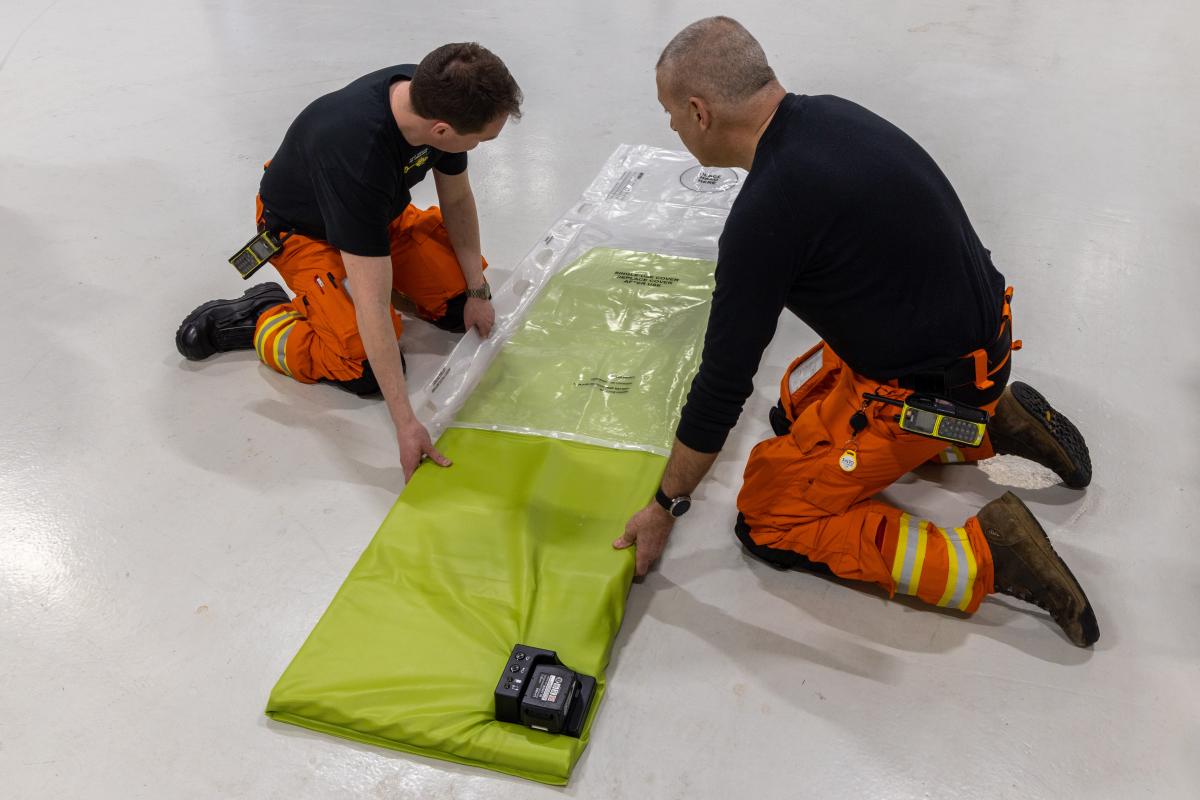Introducing the revolutionary transfer device to aid medical services and benefit patients

Vital gaps which exist in the safe handling of emergency patients are solved by ThermoTraumaPort, a revolutionary transfer device created to aid medical services and benefit patients.
Science to Business Ltd, a company which focuses on the commercialisation of game-changing medical technologies, leads a team, funded by the National Institute for Health and Care Research (NIHR) [1] and private business angels to develop the novel transfer device called ThermoTraumaPort (TTP). The team of collaborating partners, which includes East Anglian Air Ambulance (EAAA) and Wideblue (a leading product design house), is in the advanced stages of preparing the device for market release and are in the process of obtaining regulatory clearances to launch the product.
There are crucial unresolved issues with the current practice of transferring patients from an accident scene through their pre- and in-hospital journey. As explained by Russell Overend, who led the Wideblue team: “The impetus for this development came from the clinicians at the EAAA who were keen to find a solution to prevent trauma patients having to be moved multiple times for transfers between stretchers, trolleys and beds, which risks the potential of further injury.”
Another problem with standard manual handling devices, such as spine boards and scoop stretchers, used in an accident situation is that they are cold, leading to further risks due to loss of body heat. Jeremy Mauger, pre-hospital Consultant at EAAA, confirms: “We have experienced many patients exhibiting loss of body heat in trauma situations. Patients can also lose further body heat when being transferred from the scoop stretcher to other ambulance trolleys and hospital beds. Unfortunately, hypothermia is common in trauma victims and can reduce chances of survival.”
A study published in the Journal of Special Operations Medicine in June 2020 on the management of hypothermia in tactical combat casualty care showed that 66% of trauma patients arrive in emergency departments with some degree of hypothermia (< 36°C), while more than 80% of non-surviving patients had a body temperature less than 34°C [2]. Therefore, the TTP has been developed with a heating element, powered by a rechargeable battery, which warms the torso and shoulder area. This product is designed to aid patient transfer, provide warmth (if necessary) and stays with the patient during all pre- and in-hospital transfers.
An additional feature of the TTP is that it is padded. This provides a comfortable surface and reduces the risk of pressure sore development when the patient is on the device for a prolonged period of time. Furthermore, it is lightweight and foldable to fit into an ambulance, air ambulance or first-responder’s vehicle. A clean single-use plastic cover is used for each patient which facilitates transfer using the device and prevents any cross infection between patients.
Mary Anne Cordeiro, CEO of TTP Ltd, stated: “This is truly transformational for emergency transfers. We have been working with doctors from EAAA and Wideblue for the past five years on all aspects of product development, funding, usability studies, production scale-up and regulatory submissions. We have already patented the device, which has several innovative features and completed three rounds of clinical user evaluation. Potential users include air and road ambulances, first response military staff, A&E hospitals, ski patrol and mountain rescue medical teams, as well as emergency and disaster relief services. The new company TTP Ltd is ready to launch this disruptive product onto the market once all regulatory approvals are obtained.”
For further information about the ThermoTraumaPort, click here.

----------
ABOUT THE AUTHOR
Mary Anne Cordeiro
Managing Director of Science to Business
Mary Anne has been an advisor and merchant banker to innovative companies in life sciences over the past 25 years. She founded Science to Business in 2003, which is focused on the commercialisation of disruptive, game-changing medical technologies.
Mary Anne currently leads a five-year National Institute for Health and Care Research (NIHR) and angel-funded project to develop and bring to market a novel transfer device which will revolutionise emergency medicine, with co-collaborators East Anglian Air Ambulance, WideBlue and University Hospitals of Birmingham. ThermoTraumaPort Ltd has been formed to commercialise this innovation.
Mary Anne is also an experienced investment banker in corporate finance with a 15-year career (1983-1998) at Goldman Sachs, Bankers Trust and Paribas. Her role as a non-executive director of Albion Technology & General VCT PLC for almost 20 years gives Mary Anne a unique insight into the issues associated with impact investing in early-stage technology businesses.
She brings international, philanthropic and cultural diversity as founder chair and trustee of four international charities. Mary Anne was awarded an open scholarship to Worcester College, Oxford University, to read Chemistry and graduated with MA Honours (Oxon) 1979-1983.
----------
Campden Wealth is not an investment advisory service and is not a registered investment adviser or broker/dealer and has performed no due diligence and does not endorse any investment services, strategies or managers listed in Managerlink or at any other Campden Wealth event. You should perform your own extensive due diligence.
----------
[1] The mission of the NIHR is to improve the health and wealth of the nation through research. This is done by:
- Funding high quality, timely research that benefits the NHS, public health and social care;
- Investing in world-class expertise, facilities and a skilled delivery workforce to translate discoveries into improved treatments and services;
- Partnering with patients, service users, carers and communities, improving the relevance, quality and impact of our research;
- Attracting, training and supporting the best researchers to tackle complex health and social care challenges;
- Collaborating with other public funders, charities and industry to help shape a cohesive and globally competitive research system;
- Funding applied global health research and training to meet the needs of the poorest people in low- and middle- income countries.
NIHR is funded by the Department of Health and Social Care. Its work in low- and middle- income countries is principally funded through UK Aid from the UK government.
[2] B. L. Bennett, PhD1 ; Gordon Giesbrecht, PhD2 ; Ken Zafren, MD3 ; Ryan Christensen4 ; Lanny Littlejohn, MD5; Brendon Drew, DO6 ; Andrew Cap, MD, PhD7; Ethan Miles, MD8 ; Frank Butler, MD9 ; John B. Holcomb, MD10; Stacy Shackelford, Journal of Special Operations Medicine, June 2020.






